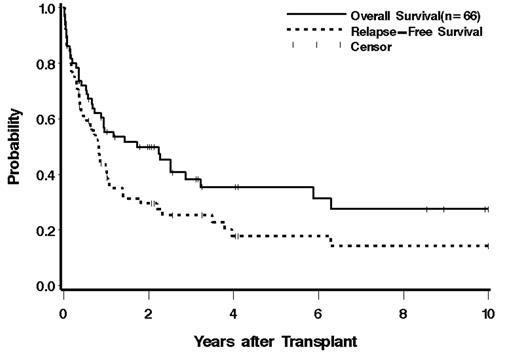Abstract
High-dose therapy (HDT) with autologous stem cell transplantation (ASCT) is the standard treatment for patients (pts) with chemosensitive relapsed or refractory Hodgkins lymphoma (HL). Unfortunately, there are few established options for HL pts with chemoresistant disease and data regarding the efficacy of HDT and ASCT in this setting are limited. One hundred and seventy-two patients underwent HDT followed by ASCT for HL at our centers between 1971 and 2005. Of these, 66 pts (38.6%) had chemoresistant disease defined as < 50% reduction in the size of the tumor with the chemotherapy regimen immediately preceding HDT. The baseline characteristics of these pts included: median age = 34 years (yrs) (range, 14–59 yrs), male = 39 (59%), stage I/II= 15 (23%), stage III = 17 (26%), Stage IV = 34 (51.5%), ≥ 5cm tumor bulk = 23 (35%), > 1 extranodal site of disease (ENS) = 13 (20%), median # of prior regimens = 2 (range 1–5), and prior radiation (RT) = 34 (52%). Histologies included nodular sclerosis (NS) in 53 (80%), mixed-cellularity in 11 (17%), and lymphocyte predominant in 2 (2%). Twenty-seven pts (41%) received TBI-based preparative regimens and 39 (59%) underwent non-TBI conditioning with the most common chemo-only regimen of bulsulfan, melphalan, thiotepa used in 19 pts.The estimated 5-year overall (OS) and progression-free survival (PFS) of this cohort was 31% and 18%, respectively with a median follow-up of 2.6 yrs among surviving pts (Figure). Twenty-two (56%) of the 39 deaths were due to relapse and 17 (44%) resulted from non-relapse causes including: 7 infections, 5 pulmonary, 1 cardiac, 1 hepatic, 1 renal, and 2 (5%) unknown causes. Multivariable modeling utilizing the above baseline criteria identified factors that were statistically significantly associated with inferior OS and PFS. These included: NS histology (OS: HR=3.8, p=0.03; PFS: HR=2.5, p=.03), non-TBI conditioning (OS: HR=2.6, p=0.009; PFS: HR=2.1, p=.02), 2 or more ENS (OS: HR=4.1, p=.0005; PFS: HR=3.7, p=0.0008); and male gender (OS: HR=2.0, p=.05; PFS: HR=2.0, p=.03) These data suggest that HDT and ASCT may result in prolonged remissions and survival for a significant minority of chemoresistant HD pts, with improved outcomes observed in those treated with TBI-based regimens, non-NS histology, female gender, and fewer ENS, though novel improved therapies for these patients are still required.
Author notes
Corresponding author


This feature is available to Subscribers Only
Sign In or Create an Account Close Modal